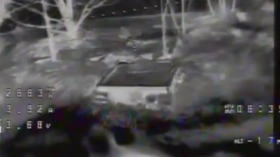'Potential city killer' asteroid with an orbiting moon flies near Earth

The 1998 QE2 asteroid, 2.7 km in diameter and dubbed a "potential city killer," with its own moon rotating around it, passed Earth on Friday, giving astronomers the only opportunity for at least the next two centuries to observe the celestial body.
The asteroid came within 3.6 million miles of Earth, closer than ever before in astronomical terms - just 5.8 million kilometers or about 15 times the distance between Earth and the moon - giving a unique opportunity for astronomers to learn as much as possible about it.
#asteroidQE2 has sailed harmlessly past Earth. Its next pass, on July 12, 2028 will be at a very safe 45 million miles (73 mil km).
— Asteroid Watch (@AsteroidWatch) May 31, 2013
Radar observations led by scientist Marina Brozovic of NASA's Jet
Propulsion Laboratory revealed a surprising fact about the
asteroid when it was about 6 million kilometers from Earth. Using
a 70-meter Deep Space Network antenna at Goldstone, California
NASA detected a moon that was rotating around it. These binary or
triple systems make up about 16 percent of asteroids in the
near-Earth population. The diameter of the asteroid’s satellite
was estimated at approximately 600 meters and the rotation period
of less than four hours.
In comparison, the Chelyabinsk meteorite that hit Russia in February, injuring more than 1,500 people, was about 20 meters. While the 1908 Tunguska meteoroid was estimated at about 100 meters as the explosion it produced was recognized to have been the largest impact event on or near Earth in recorded history.
Events in Russia in February have triggered debate about the threat our civilization faces from asteroids.
“An asteroid that size, a kilometer or bigger, could plausibly end civilization,” John Holdren, a White House science advisor, told legislators at a US House of Representatives Science Committee hearing in May. However only about 10 percent of an estimated 10,000 potential "city-killer" asteroids, those with a diameter of about 50 meters, have been found, Holdren added.
The closest approach of the asteroid came on Friday at 20:59 GMT, however the best time to observe the celestial projectile will be the first week of June, when the asteroid enters the Earth’s northern skies. At that time it will turn its sunlit side towards our planet.

NASA previously said that it will be visible through a usual
backyard telescope despite its relative distance from Earth. At
maximum brightness on June 3 and 4 it is expected to shine as an
11th magnitude star.
The 1998 QE2 will only pass earth again in the next two centuries, so scientists won’t get another such opportunity to study it.
NASA plans to exploit radars to reveal the alien landscape that no one has ever seen before.
"It is tremendously exciting to see detailed images of this asteroid for the first time," said radar astronomer Lance Benner, the principal investigator for the Goldstone radar observations from NASA's Jet Propulsion Laboratory in Pasadena, California.
Aside from monitoring potential threats, radar observations allow the opportunity to learn more about the origins of our solar system, the source of water on Earth, and even the origin of organic molecules that lead to the development of life, says NASA.
"With radar we can transform an object from a point of light into a small world with its own unique set of characteristics. In a real sense, radar imaging of near-Earth asteroids is a fundamental form of exploring a whole class of solar system objects," acknowledged Benner.
Another thing that intrigues scientists is the asteroid’s dark complexion. According to the measurements of the Spitzer space telescope QE2 reflects only 6 percent of the light that falls on it, which makes it blacker than coal. Benner says it makes QE2 similar to a carbon rich 101955 Bennu asteroid, adding that the latter can harbor amino acids and other organic molecules essential to primitive life.
The asteroid 1998 QE2 was discovered on August 19, 1998, by the Massachusetts Institute of Technology Lincoln Near Earth Asteroid Research (LINEAR) program near Socorro, New Mexico. The asteroid is believed to be nine-Queen Elizabeth II ship-lengths in size but it is not named after the transatlantic-crossing flagship. Instead, the name is assigned by the NASA-supported Minor Planet Center in Cambridge, Massachusetts, which “gives each newly discovered asteroid a provisional designation starting with the year of first detection, along with an alphanumeric code indicating the half-month it was discovered, and the sequence within that half-month.”
While NASA is tracking about 95 per cent of the largest objects flying near Earth, scientists are trying to find ways to eliminate the potential threat of one of the celestial bodies hitting our planet.
Following the Chelyabinsk meteor strike, the European Space Agency (ESA) announced a joint Asteroid impact and Deflection Assessment mission (AIDA) between Europe and the US that aims to strike an asteroid with a spacecraft.














